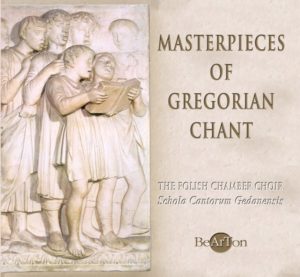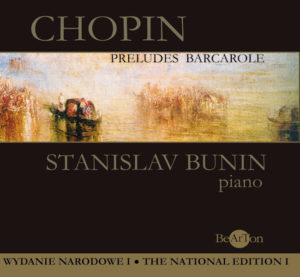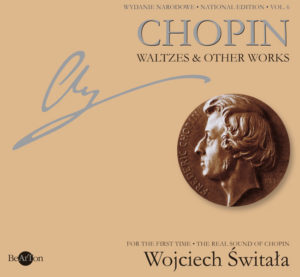Chopin – Piano concertos (single piano version)
Chopin – Piano concertos (single piano version)
Cat No. CDB041
Music disc: CD-AUDIO
Performer:
Yuko Kawai – piano
Disc content:
Concerto for piano and orchestra in F minor Op.21
- Maestoso – 15’04”
- Larghetto – 9’20”
- Allegro vivace – 9’53”
Concerto for piano and orchestra in E minor Op.11
- Allegro maestoso – 20’35”
- Romance. Larghetto – 9’29”
- Rondo. Vivace – 11’10”
Total time – 76’30”
Listen a part
42.99złAdd to basket
© ℗ 2010 Bearton
Piano Concertos: Single-Piano Versions
This album is a continuation of the phonographic cycle of the National Edition Series A, containing the pieces published during Chopin’s lifetime. It includes the piano concertos in the single-piano versions, played by the Japanese pianist, Yuko Kawai. During the composer’s days, the genre was performed in four versions. The single-piano version was a basic editorial form of the piano pieces with orchestra accompaniment at that time, as well as a method of music presentation in salons and in concert halls sometimes. That is indicated by the composers notes to be observed when the piece is played without accompaniment. Such notes are found in Chopin’s concerto works op. 2 and 14, and in the student’s sheet music of the Piano Concerto in F minor. It is quite probable that the Piano Concerto in E minor was performed in the single-piano version by the composer himself in public. The printed score of that version was supplemented by orchestral voices available for a string quintet or an orchestra. The versions with two pianos were used in home performances, by students and sometimes at public concerts. However, those versions were not published during Chopin’s lifetime and were included in the National Edition Series B. The version with a string quartet or quintet was played both at concerts and in salons. It was mainly performed by string instrument voices, and the scores contained the essential entrances of wind instruments. Finally, the orchestral versions were basic ones in the composer’s intention. Chopin played the Piano Concerto in E minor several times in that version in public. Both piano concertos were composed one after another soon, the first being the Piano Concerto in F minor op. 21, in 1829-1830, often mistakenly treated as the second in sequence owing to the fact that it was published later than the Piano Concerto in E minor op. 11, composed in the autumn of 1830.
The circumstances of the origin of the first of the two concertos were revealed by the composer in his letter to Tytus Wojciechowski: …possibly, to my misfortune, I have my ideal that I have been worshipping faithfully, without talking to, for half a year, dreaming of her and commemorating her by my Adagio to my Concerto… That ideal was Chopin`s peer the beautiful Konstancja Gładkowska . The young composer`s enchantment was serious and lasted long after he had left Warsaw. However, the lady probably had not treated her admirer that seriously since she burned all his letters sent to her .Let me also add the first of Chopin`s muses was replaced by the addresse of the Piano Concerto in F minor dedication (1836) upon its publication, Delfina Potocka.
The structure and nature of the Concerto complies with the brillant style convention. The first part has the form of the sonata allegro with double exposition, while the second part has the form of the song, with the third one being a rondo. The Allegro is essentially saturated with a large dose of lyricism, especially in the second theme, with an unusual Chopin`s cantilena, oscillating between a lively march and the moments of reverie, between con anima and sostenuto. The second part, Larghetto, having the form of the nocturne, occupies the central place in the Concerto`s dramaturgy, justifying the sense of its message…
The Larghetto raised enchantment since its first performance. Wherever I go, Chopin confided, they remind me of my Adagio. Maurycy Mochnacki praises it to the skies. In 1949, Zbigniew Jachimecki included that part of the Concerto among the most beautiful chapters of the 19th century erotic poetry, while Tadeusz A. Zieliński doubted in 1993 whether it would be ever possible to find an equally suggestive, passionate and moving a vow of love contained in sounds in the musical literature. The final Rondo brings a radical contrast in comparison to the two preceding parts, exposing music full of life, serenity and humour, the music which is filled with folk dance aspects. That is actually a concert mazur stylisation, although the first phrases of the theme remind us rather of a kujawiak.

Yuko Kawai
The Piano Concerto in E minor op. 11 is also a partial expression of young Fryderyk’s feelings to beautiful Konstancja as he added the following thought to his work: …The Adagio to my Piano Concerto in E minor: it is not meant to be strong. It is rather romantic and melancholic. It should make an impression of your pleasant glance at the place where you evoke a thousand dear memories: a kind of musing in beautiful spring time and in moonlight… In his Piano Concerto in E minor, which was undoubtedly still affected by the brillant style, Chopin seemed to be rather moderate in releasing his sentimental gestures. One can hear there virtuoso swings and gusts of feelings, as well as sweet lyricism of the Larghetto: all, however, being more mature than the same in his earlier pieces. The three parts of the Concerto: the brilliant Allegro maestoso, the delicate Larghetto sung as if sotto voce, and the lively Rondo, with the rhythms of the krakowiak, produce a truly romantic piece which, together with his Piano Concerto in F minor, open a new chapter in the piano music history. The work is filled with feelings, but without excess or exaggeration so characteristic for Chopin’s predecessors and contemporaries.
The music of both Concertos, noticed Piotr Wierzbicki, […] is turned, from the beginning to the end, backwards in its emotional layer, in order for one to muse about the places associated with thousands of nice memories in moonlight…
Marek Wieroński





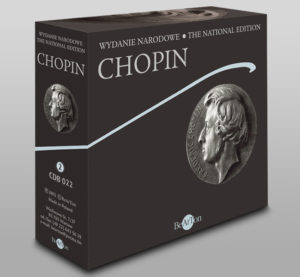










![Chopin – Walce [B] i inne utwory CDB047](https://www.bearton.pl/wp-content/uploads/Chopin-Walce-B-i-inne-utwory-CDB047-A-300x277.jpg)
![Chopin – Pieśni [B] CDB046](https://www.bearton.pl/wp-content/uploads/Chopin-Piesni-CDB046-A-300x277.jpg)





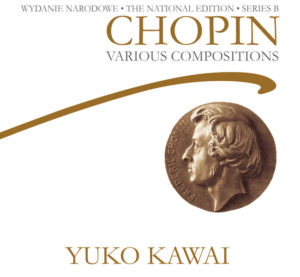

![Chopin - Mazurki i inne utwory [B] CDB038](https://www.bearton.pl/wp-content/uploads/Chopin-Mazurki-i-inne-utwory-B-CDB038-A-300x277.jpg)
![Chopin – Polonezy [B] CDB037](https://www.bearton.pl/wp-content/uploads/Chopin-Polonezy-B-CDB037-A-300x277.jpg)


